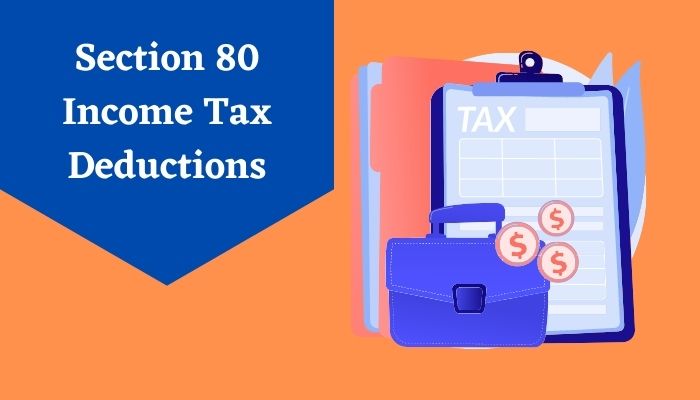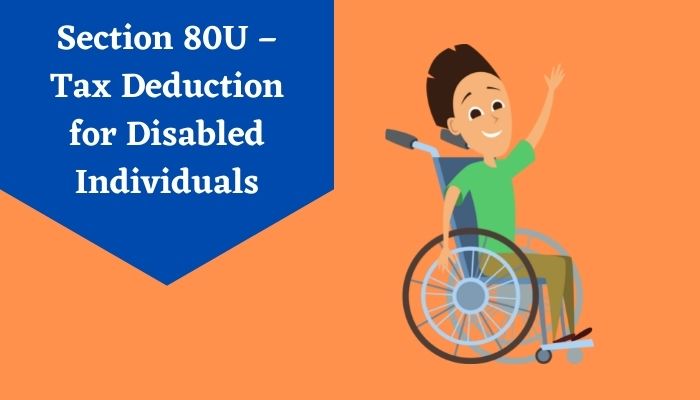Section 80 Income Tax Deductions
Paying income tax is important. But if you use any income tax calculator, then there are pretty good chances that you would get worried after seeing that total amount. However, there is an easy way out. There are several deductions that one can get to reduce the amount of total payable taxes. Today, we’ll help you learn more about tax exemption.
Deductions of Investment from Taxable Income through Section 80C
It is possible that some of your investments give you more than expected returns. And in those cases, you would want to save tax. Understanding this type of tax exemption is important.

The deductions under Section 80C can be availed by individuals and a Hindu Undivided Family (HUF). There are also other investments under which these income tax rules are applicable. These investment options are:
- Investment in Public Provident Fund (PPF)
- Equity Linked Savings Schemes (ELSS)
- Unit Linked Savings Schemes (ULIPs)
- National Saving Certificates (NSC)
- Employee’s share of Provident Fund Contribution
- Children’s tuition fee
- Life insurance premium payment
- Senior Citizens Savings Scheme (SCSS)
- Principal repayment of home loan
The maximum deduction available under these tax-saving investments is INR 1,50,000. It should be noted that the maximum deduction provided is applicable for this section only.
Further, cumulatively, the maximum deduction that can be claimed under Section 80C, Section 80CC, and Section 80CCD(1) is INR 1,50,000. Beyond this, an additional INR 50,000 can be claimed as a tax deduction for investment in the National Pension Scheme (NPS) account under Section 80CCD (1B).
Learning More about Tax Planning and Section 80C
Under Section 80CCC deduction rules of contribution to pension funds are included. This is designed to reduce the income tax liability on the pension plans offered by several public and private sector insurers.
One can find a deduction to an individual who has paid or deposited an amount in any annuity plan of an insurer for receiving a pension from a fund. This fund should be set by an insurer. There is a deduction of premium paid during the year that can be claimed as deductions from taxable income.
The maximum amount of deduction that can be claimed is INR 1,50,000. This deduction is a cumulation of deductions claimed under Section 80C, Section 80CC, and Section 80CCD (1).
Deduction of Contribution to Pension Scheme of Central Government through Section 80CCD
The deductions that are applicable under Section 80CCD are allowed for an individual who makes a deposit to his or her pension account. The maximum deduction allowed in this case is equal to 10% of the salary of the individual and 20% of the gross total income for self-employed individuals.
There is also a cap on the maximum deduction allowance. This cap is INR 1,50,000. An additional deduction of up to INR 50,000 can also be claimed for any contributions made towards NPS by individuals.
It should be noted that both the sections that have been mentioned above are tied with pension plans and annuity plans. One should remember that there is a difference between both of these plans. Section 80CCC covers all deductions for the amount paid towards the annuity plan of any insurer and Section 80CCD provides a deduction for the amount contributed to pension schemes.
Deduction of Premium Paid for Medical Insurance through Section 80D
Under section 80D, individuals can claim deductions of up to INR 25,000. This is allowed to taxpayers for insurance of self, spouse, and dependent children. If the age of the insured is 60 years or more than 60 years, then the amount of deductions that one can claim is up to INR 30,000.
Beyond this, an additional deduction of insurance for parents, father, mother, or both are allowed up to a limit of INR 25,000. This value is bumped up to INR 30,000 if the age of the parties involved is either 60 years or more than 60 years. One can also avail a deduction for a preventive health check-up. The upper limit for this deduction is INR 5,000. Hence, in total, a maximum deduction of INR 60,000 is applicable.
Deduction of Interest Paid on Education Loans Taken for Higher Studies through Section 80E
If an individual has taken an education loan for pursuing higher studies, then one can claim tax deduction under Section 80E. This is applicable even when the loan amount may have been taken for the spouse, children, or for a student for whom the taxpayer is a legal guardian.
The deduction valid under Section 80E is allowed on the interest amount of the loan and is available for a maximum of 8 years or the interest amount is paid. One can even claim the deduction under this section if the loan has been taken for financing higher studies in a foreign nation. There are no restrictions on the maximum amount of deduction applicable under this section.
Tax Deductions on Paid House Rent through Section 80GG
If an individual does not receive House Rent Allowance (HRA) in his or her salary, then he or she can claim a deduction for the house rent paid under Section 80GG. For this deduction to be valid, the taxpayer, spouse, or the minor child must not own residential accommodation at the place of employment.
The taxpayer should be living on rent and should be paying the rent regularly. Further, the taxpayer should not have any self-occupied residential properties in any other place. This deduction is applicable to a minimum value of rent paid minus 10% of the total income, INR 5,000 per month, or 25% of the total income. The maximum deduction applicable is INR 60,000.
Deduction of Interest on Savings Account through Section 80TTA
Under this section, a deduction can be claimed against the interest income that has been gained from the savings bank account. This source of income should be included under the ‘other income’ tab and one can avail of a deduction of a maximum of INR 10,000.





























